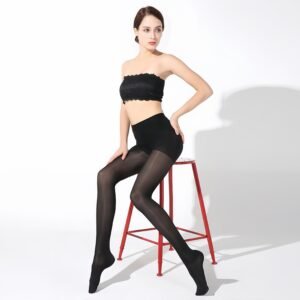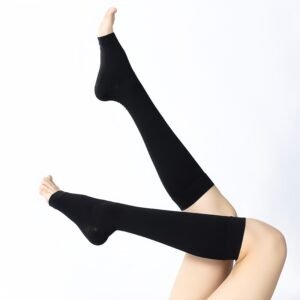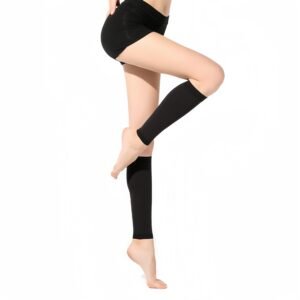Calze a compressione medica
Le calze a compressione medicale sono un tipo di calzetteria specializzata progettata per applicare una leggera pressione alle gambe e ai piedi. Questa pressione aiuta a migliorare il flusso sanguigno, a ridurre il gonfiore e a dare sollievo a varie patologie delle gambe. A differenza delle calze a compressione con punta aperta, che lasciano scoperte le dita dei piedi, le calze medicali a compressione racchiudono l'intero piede, offrendo una copertura e un sostegno completi.
Il design di queste calze prevede in genere una compressione graduata: la pressione è massima alle caviglie e diminuisce gradualmente lungo la gamba. Questa compressione graduata favorisce il ritorno venoso, assicurando un flusso sanguigno più efficiente verso il cuore. In genere, le calze medicali a compressione sono realizzate con materiali elastici come nylon, spandex e lycra, che garantiscono l'elasticità e la durata necessarie.
Le calze a compressione medicali sono utilizzate per un'ampia gamma di scopi. Sono spesso prescritte da professionisti del settore sanitario a persone affette da patologie quali vene varicose, trombosi venosa profonda e insufficienza venosa cronica. Gli atleti le utilizzano anche per migliorare le prestazioni e accelerare il recupero, migliorando la circolazione e riducendo l'affaticamento muscolare. Inoltre, queste calze sono utili per coloro che trascorrono lunghi periodi seduti o in piedi, come chi lavora in ufficio e chi viaggia, per evitare fastidi e gonfiori alle gambe.
Coprendo l'intero piede, le calze medicali a compressione offrono maggiore calore e protezione, rendendole adatte ai climi più freddi o alle persone che preferiscono una copertura totale del piede. Questa caratteristica può essere particolarmente vantaggiosa per i pazienti affetti da diabete o da altre patologie che richiedono una maggiore cura e protezione del piede.
Nel complesso, le calze medicali a compressione sono uno strumento versatile ed essenziale per la gestione della salute di gambe e piedi. Il loro design unico e la composizione dei materiali le rendono efficaci per varie applicazioni mediche e quotidiane, ponendo le basi per l'esplorazione dettagliata dei loro benefici, usi e suggerimenti nelle sezioni seguenti.
Benefici per la salute delle calze a compressione medica
Le calze a compressione medicale offrono numerosi vantaggi per la salute che le rendono una valida aggiunta a molti guardaroba. Uno dei vantaggi principali è la loro capacità di migliorare la circolazione sanguigna. Applicando una pressione graduata sulle gambe, queste calze aiutano a facilitare il flusso di sangue verso il cuore. Ciò è particolarmente vantaggioso per le persone che trascorrono lunghi periodi in piedi o sedute, in quanto aiuta a prevenire il ristagno del sangue nelle estremità inferiori.
Un altro beneficio significativo per la salute è la riduzione del gonfiore, noto anche come edema. Le calze a compressione esercitano una pressione sui tessuti e sulle vene, contribuendo a ridurre la fuoriuscita di liquidi dalle vene agli spazi dei tessuti. Questa caratteristica le rende particolarmente utili per le donne in gravidanza, che spesso soffrono di gonfiore alle gambe e ai piedi. Inoltre, anche le persone affette da patologie come il linfedema possono trarre sollievo dall'uso regolare di calze medicali a compressione.
La prevenzione della trombosi venosa profonda (TVP) è un altro vantaggio fondamentale. La TVP è una condizione in cui si formano coaguli di sangue nelle vene profonde, in genere nelle gambe. Questi coaguli possono essere pericolosi se raggiungono i polmoni, causando un'embolia polmonare. Le calze a compressione medicale contribuiscono a ridurre il rischio di TVP mantenendo un flusso sanguigno costante e prevenendo il ristagno di sangue che può portare alla formazione di coaguli.
Gruppi specifici possono trarre ancora più vantaggio da queste calze. Gli atleti, ad esempio, le usano spesso per migliorare le prestazioni e accelerare il recupero. Il miglioramento della circolazione aiuta a fornire più ossigeno ai muscoli, riducendo l'affaticamento e favorendo un recupero più rapido dopo l'esercizio. Per le donne in gravidanza, oltre a ridurre il gonfiore, queste calze possono alleviare il disagio e ridurre il rischio di vene varicose. Anche le persone affette da patologie croniche come il diabete o le arteriopatie periferiche possono trarre beneficio, in quanto il miglioramento della circolazione e la riduzione del gonfiore contribuiscono a migliorare la salute generale degli arti.
In sostanza, le calze medicali a compressione sono uno strumento versatile per promuovere la salute vascolare, a beneficio di un'ampia gamma di individui, dagli atleti a coloro che soffrono di condizioni mediche specifiche.
Diversi tipi di calze a compressione medica
Le calze medicali a compressione sono disponibili in diversi tipi, ciascuno progettato per soddisfare esigenze e preferenze specifiche. Conoscere le diverse opzioni disponibili è fondamentale per scegliere il paio giusto che fornisca i massimi benefici.
In primo luogo, i livelli di compressione sono un fattore importante. I livelli di compressione variano da lieve a extra-forte, ognuno dei quali offre diversi gradi di supporto. Le calze a compressione leggera, che di solito vanno da 8 a 15 mmHg, sono adatte all'uso quotidiano e possono contribuire ad alleviare gonfiori e affaticamenti minori. La compressione moderata, compresa tra 15 e 20 mmHg, è ideale per chi soffre di gonfiori più pronunciati o necessita di un sostegno supplementare durante le attività fisiche. La compressione forte, compresa tra 20 e 30 mmHg, è spesso consigliata a chi soffre di patologie più gravi, come le vene varicose o la trombosi venosa profonda. La compressione extra-forte, superiore a 30 mmHg, è solitamente utilizzata sotto controllo medico per condizioni gravi.
Anche la lunghezza delle calze compressive gioca un ruolo importante nella loro efficacia. Le calze lunghe fino alla caviglia sono perfette per contrastare il gonfiore e il disagio nella parte inferiore della gamba e del piede. Le calze compressive alte fino al ginocchio forniscono una copertura più ampia, offrendo un supporto dal piede fino al ginocchio, rendendole popolari tra gli atleti e le persone con problemi circolatori. Le calze compressive alte fino alla coscia si estendono ulteriormente, offrendo un supporto completo a tutta la gamba, utile per il recupero post-chirurgico o per i disturbi venosi gravi.
La composizione del materiale è un altro fattore critico. Sono comuni le miscele di nylon e spandex, che offrono durata, flessibilità e proprietà efficaci di traspirazione. Questi materiali garantiscono che le calze a compressione siano comode e funzionali. Le miscele di cotone, invece, offrono una sensazione più morbida e sono ideali per i soggetti con pelle sensibile. La scelta del materiale giusto è essenziale per garantire il comfort e ottimizzare i benefici terapeutici delle calze compressive.
Considerando questi fattori - livelli di compressione, lunghezze e materiali - le persone possono scegliere le calze medicali a compressione più adatte a soddisfare le loro esigenze specifiche, migliorando il comfort e i risultati di salute.
Come scegliere le giuste calze mediche a compressione
La scelta delle giuste calze medicali a compressione è fondamentale per massimizzarne i benefici e garantire il comfort. La prima fase di questo processo consiste nel determinare il livello di compressione appropriato. Le calze a compressione sono disponibili in vari livelli di pressione, tipicamente misurati in millimetri di mercurio (mmHg). Una compressione leggera (15-20 mmHg) è ideale per l'uso quotidiano e per i sintomi lievi, mentre i livelli di compressione moderata (20-30 mmHg) e decisa (30-40 mmHg) sono consigliati per le condizioni più gravi, come l'insufficienza venosa cronica o il recupero post-chirurgico. La consulenza di un operatore sanitario può aiutare a scegliere il livello di compressione giusto in base alle esigenze individuali.
Un altro fattore fondamentale è la scelta della taglia corretta. Le calze a compressione troppo strette o troppo larghe possono causare disagio o non fornire i benefici terapeutici previsti. Le tabelle di dimensionamento sono solitamente fornite dai produttori e richiedono misure della caviglia, del polpaccio e talvolta della coscia. È essenziale prendere queste misure con precisione, preferibilmente al mattino quando il gonfiore è minimo.
L'importanza di una corretta vestibilità non può essere sopravvalutata. Le calze compressive che non calzano bene possono causare problemi come la limitazione del flusso sanguigno o l'irritazione della pelle. Quando si provano le calze a compressione, assicurarsi che non ci siano grinze o arricciamenti, in particolare intorno alle caviglie e alle dita dei piedi. Le calze devono essere aderenti, ma non troppo, e devono rimanere al loro posto senza scivolare durante la giornata.
Anche le caratteristiche specifiche possono migliorare la funzionalità e il comfort delle calze medicali a compressione. Cercate caratteristiche come il materiale traspirante, che aiuta a mantenere i piedi asciutti, o la compressione graduata, che favorisce una migliore circolazione essendo più stretta alla caviglia e gradualmente più allentata lungo la gamba. Alcune calze offrono anche talloni e punte rinforzate per una maggiore durata e comfort.
Infine, è essenziale testare le calze per verificarne il comfort e l'efficacia. Inizialmente indossatele per un breve periodo per assicurarvi che non vi siano reazioni avverse. Aumentate gradualmente il tempo in cui indossate le calze per consentire alle vostre gambe di adattarsi. Se si verificano fastidi o sintomi insoliti, potrebbe essere necessario rivalutare la vestibilità o il livello di compressione.
Prendendo in considerazione questi fattori, è possibile fare una scelta informata che fornisca i massimi benefici terapeutici e il massimo comfort dalle calze medicali a compressione.
Uso e cura corretti delle calze mediche a compressione
Per beneficiare appieno delle calze a compressione medica, è fondamentale comprendere i metodi corretti per indossarle e mantenerle. L'uso corretto inizia con il sapere come indossarle e toglierle correttamente. Per indossarle, iniziare a inserire la mano nella calza e girarla al rovescio fino al tallone. Inserite il piede nella calza, assicurandovi che le dita raggiungano comodamente l'area della punta chiusa. Arrotolare gradualmente la calza verso l'alto sulla caviglia e sul polpaccio, appianando le eventuali grinze per garantire una distribuzione uniforme della pressione. Per togliere la calza bisogna invertire il procedimento, partendo dall'alto e arrotolandola delicatamente verso il basso per evitare di stirare o danneggiare eccessivamente il tessuto.
La durata dell'uso delle calze medicali a compressione varia in base alle esigenze individuali e al parere del medico. In genere si indossano durante le ore di veglia e si tolgono prima di andare a letto. Indossarle per periodi prolungati, soprattutto durante la notte, potrebbe non essere necessario se non diversamente indicato da un medico. Consultare sempre un medico esperto per determinare il programma di utilizzo ottimale in base alla propria condizione specifica.
Ci sono diverse precauzioni da prendere in considerazione quando si usano le calze a compressione. Assicurarsi che la taglia e il livello di compressione siano corretti per evitare fastidi o problemi di circolazione. Tenere sotto controllo la pelle per individuare eventuali segni di irritazione, arrossamento o gonfiore, che potrebbero indicare un'inadeguata vestibilità o una reazione allergica. È inoltre importante evitare di piegare o arrotolare la parte superiore delle calze, in quanto ciò può creare un effetto laccio emostatico, limitando potenzialmente il flusso sanguigno.
Per mantenere l'efficacia e la durata delle calze medicali a compressione è necessaria una cura adeguata. Si raccomanda il lavaggio a mano per preservare l'elasticità del tessuto. Utilizzare un detergente delicato e acqua tiepida, evitando candeggina o ammorbidenti. Dopo il lavaggio, strizzare delicatamente l'acqua in eccesso e stendere le calze all'aria, lontano da fonti di calore dirette e dalla luce del sole. L'osservanza di queste linee guida contribuirà a garantire che le calze a compressione rimangano efficaci e durature, fornendo il supporto necessario alle vostre esigenze.
Miti e idee sbagliate comuni
Le calze a compressione medicali hanno guadagnato popolarità grazie ai loro benefici per la salute, ma diversi miti e idee sbagliate ne circondano ancora l'uso. Uno dei miti più diffusi è che le calze a compressione siano destinate esclusivamente agli anziani. Sebbene gli anziani possano trarre notevoli benefici dal loro uso, le calze a compressione sono utili per individui di tutte le età. Gli atleti, le donne in gravidanza e coloro che trascorrono molte ore in piedi o seduti possono beneficiare di una migliore circolazione sanguigna e di una riduzione del gonfiore.
Un'altra idea sbagliata comune è che chiunque possa indossare calze compressive senza consultarsi. Sebbene siano generalmente sicure, è consigliabile consultare un operatore sanitario prima di iniziare a usarle, soprattutto per i soggetti con condizioni mediche di base. Un'adeguata vestibilità e il corretto livello di compressione sono fondamentali per massimizzare i benefici ed evitare potenziali complicazioni. Il consiglio del medico assicura che la scelta delle calze compressive sia in linea con le specifiche esigenze di salute, sia che si tratti di gestire l'insufficienza venosa cronica, prevenire la trombosi venosa profonda o alleviare il gonfiore delle gambe durante la gravidanza.
Alcuni ritengono che le calze a compressione siano scomode o difficili da indossare, il che può scoraggiare i potenziali utilizzatori. I modelli moderni sono notevolmente migliorati in termini di comfort e facilità d'uso. I materiali utilizzati oggi sono più traspiranti e flessibili, il che li rende adatti all'uso quotidiano. Le innovazioni nel design includono anche caratteristiche come cerniere o tessuti speciali che semplificano il processo di indossamento e rimozione.
Infine, esiste il mito che indossare calze compressive possa indebolire i muscoli nel tempo. In realtà, le calze a compressione non sostituiscono l'attività muscolare. Al contrario, completano l'attività fisica migliorando la circolazione e riducendo l'affaticamento. Sono particolarmente utili per il recupero dopo l'esercizio fisico o per lunghi periodi di inattività, come durante i voli aerei o il lavoro alla scrivania.
Sfatando questi miti, speriamo di fornire una comprensione più chiara dei benefici e dell'uso appropriato delle calze medicali a compressione. Una corretta conoscenza può migliorare significativamente il benessere di una più ampia gamma di individui, assicurando loro di prendere decisioni informate sulla propria salute e sul proprio comfort.
Testimonianze e casi di studio reali
Le calze medicali a compressione si sono rivelate una svolta per molti individui, migliorando significativamente la loro qualità di vita. Esploriamo alcune testimonianze reali e casi di studio che evidenziano i benefici pratici di queste calze specializzate.
Prendiamo ad esempio Sarah, un'impiegata di 45 anni che trascorre molte ore seduta alla scrivania. Ha iniziato ad avvertire gonfiore e fastidio alle gambe, con conseguenti ripercussioni sulla sua routine quotidiana. Dopo aver consultato il suo medico, Sarah ha iniziato a indossare le calze a compressione medicale. In poche settimane ha notato una significativa riduzione del gonfiore e del dolore. Queste calze non solo le hanno dato sollievo fisico, ma l'hanno anche aiutata a mantenere uno stile di vita attivo, permettendole di partecipare alle passeggiate serali e alle attività sociali senza alcun disagio.
Un altro caso interessante è quello di John, un pensionato di 60 anni con una storia di vene varicose. John aveva provato vari trattamenti con scarso successo. Su consiglio del suo medico, ha optato per le calze a compressione medicale. La pressione costante esercitata dalle calze ha migliorato la circolazione, riducendo la prominenza delle vene varicose e alleviando il dolore associato. John riferisce ora di essere in grado di godersi appieno la pensione, dedicandosi al giardinaggio e ai viaggi senza la costante preoccupazione del dolore alle gambe.
Allo stesso modo, Maria, un'infermiera che fa lunghi turni di lavoro, ha trovato indispensabili le calze a compressione medicale. Stare in piedi per lunghi periodi le procurava gambe doloranti e stanche. Dopo aver integrato queste calze nella sua uniforme quotidiana, ha registrato un netto miglioramento dell'affaticamento delle gambe. I livelli di energia di Maria sono aumentati, consentendole di concentrarsi meglio sulla cura dei pazienti e sulle attività personali.
Queste testimonianze e casi di studio sottolineano i vantaggi pratici delle calze medicali a compressione. Offrendo sollievo da gonfiore, dolore e affaticamento, queste calze hanno permesso a molti individui di condurre una vita più comoda e attiva. Sia che si tratti di condizioni mediche o di esigenze della vita quotidiana, le calze medicali a compressione hanno dimostrato la loro validità nel migliorare il benessere generale.
Conclusione e suggerimenti finali
In conclusione, le calze medicali a compressione offrono numerosi benefici per la salute che le rendono una valida aggiunta al vostro regime di benessere. Migliorando la circolazione sanguigna, riducendo il gonfiore e alleviando il disagio alle gambe, queste calze specializzate possono migliorare significativamente la qualità di vita complessiva. Che siate atleti, viaggiatori abituali o persone che soffrono di condizioni mediche come le vene varicose o la trombosi venosa profonda, le calze a compressione medicali possono offrirvi il sostegno e il sollievo di cui avete bisogno.
Quando si sceglie il giusto paio di calze a compressione, bisogna considerare fattori quali il livello di compressione, il materiale e la vestibilità. È essenziale scegliere calze che offrano il livello di compressione appropriato per le vostre esigenze specifiche, che va da lieve a extra-forte. Inoltre, materiali traspiranti e resistenti come il nylon e l'elastan assicurano comfort e durata. La corretta vestibilità è fondamentale per massimizzare i benefici, quindi prendete le misure accurate delle vostre gambe e fate riferimento alle tabelle delle taglie fornite dai produttori.
Per un utilizzo ottimale, indossare le calze medicali a compressione durante le attività che affaticano le gambe, come lunghi voli, posizione eretta prolungata o allenamenti intensivi. Assicurarsi di seguire le istruzioni per l'uso e la manutenzione consigliate per mantenerne l'efficacia. Le calze a compressione devono essere lavate regolarmente e sostituite periodicamente per garantire che continuino a fornire un supporto adeguato.
Le calze a compressione di alta qualità sono disponibili presso varie marche rinomate e possono essere acquistate online o nei negozi specializzati. Cercate prodotti con recensioni positive e certificazioni per essere certi di investire in un abbigliamento compressivo affidabile ed efficace. Incorporando le calze a compressione medicali nella vostra routine quotidiana, potete adottare misure proattive per migliorare la salute delle gambe e il benessere generale.


















Recensioni
Ancora non ci sono recensioni.